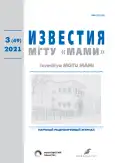A virtual test bench for determining the loads in the air suspension of the rear trolley of a truck at the early stages of design
- Authors: Maksimov R.O.1, Chichekin I.V.1
-
Affiliations:
- Bauman Moscow State Technical University
- Issue: Vol 15, No 3 (2021)
- Pages: 76-86
- Section: Articles
- URL: https://journals.rcsi.science/2074-0530/article/view/105551
- DOI: https://doi.org/10.31992/2074-0530-2021-49-3-76-86
- ID: 105551
Cite item
Full Text
Abstract
To determine the maximum loads acting in the rear air suspension of a truck at the early stages of design there was used computer modeling based on solving equations of dynamics of solids and implemented in the Recurdyn software. The components of the developed virtual test bench, including hinges, power connections, drive axles, a wheel-hub assembly with a wheel and a support platform, are considered in detail. The test bench is controlled using a mathematical model created in the environment for calculating the dynamics of rigid bodies and associated with a solid suspension model by standard software tools of the application. The test bench is controlled using a mathematical model created in the environment for calculating the dynamics of rigid bodies and associated with a solid suspension model by standard software tools of the application. The use of such a test bench makes it possible to determine the loads in the hinges and power connections of the suspension, to determine the mutual positions of the links for each load mode, to increase the accuracy of the calculation of loads in comparison with the flat kinematic and force calculation. The mathematical model of the virtual test bench allows to carry out numerous parametric studies of the suspension without the involvement of expensive full-scale prototypes. This makes it possible at the early stages of design to determine all hazardous modes, select rational parameters of the elements, and reduce design costs.
The paper shows the results of modeling the operation of a virtual test bench with an air suspension in the most typical loading modes, identifying the most dangerous modes. The efficiency and adequacy of the mathematical model of the suspension was proved. Examples of determining the force in all the joints of the structure, the choice of maximum loads for design calculations when designing the air suspension of vehicle were shown.
Full Text
##article.viewOnOriginalSite##About the authors
R. O. Maksimov
Bauman Moscow State Technical University
Author for correspondence.
Email: romychmaximov@gmail.com
Russian Federation, Moscow
I. V. Chichekin
Bauman Moscow State Technical University
Email: hiv2@mail.ru
PhD in Engineering
Russian Federation, MoscowReferences
- Vdovin D.S. Calculation of loads on the independent suspension links of the chassis of an 8 wheel drive vehicle using Nx Motion. Sbornik trudov sektsii “Avtomobili i traktorY” 85-oy mezhdunarodnoy nauchno-tekhnicheskoy konferentsii «Budushcheye avtomobilestroyeniya v RossiI», Assotsiatsiya Avtomobil'nykh Inzhenerov, Universitet Mashinostroyeniya (MAMI), Moscow, 24 aprelya 2014 g. [Proceedings of the section “Automobiles and tractors” of the 85th international scientific and technical conference “Future of the automotive industry in Russia”]. pp. 2−6 (in Russ.).
- Gorobtsov A.S., Kartsov S.K., Polyakov YU.A., D'yakov A.S. Dynamic analysis of the parameters of the front suspension of the truck cabin. Izvestiya MGTU «MAMI». 2014. No 4(22). V 1, pp. 74–80 (in Russ.).
- Gorobtsov A.S., Shurygin V.A., Serov V.A., D'yakov A.S., Lapteva V.O., Makarov A.A. Development of a mathematical model of a multi-support transport vehicle for the transportation of large-sized indivisible cargo. Gruzovik. 2014. No 11, pp. 2−5 (in Russ.).
- Xiaobin Ning et al. Dynamic Analysis of Car Suspension Using ADAMS/Car for Development of a Software Interface for Optimization / Procedia Engineering 16 (2011) 333 – 341.
- Kushvid R.P., Chichekin I.V. Shassi avtomobilya. Konstruktsiya i elementy rascheta [Vehicle chassis. Design and elements of calculation]: uchebnik. Moscow: MGIU Publ., 2014. 555 p.
- Ravkin G.O. Pnevmaticheskaya podveska avtomobilya [Air suspension of vehicle] / Pod red. kand. tekhn. nauk A.A. Lapina. Moscow: Mashgiz Publ., 1962. 288 p.
- Raympel' Y. Shassi avtomobilya: Elementy podveski [Automobile chassis: Suspension elements]. Per. s nem. A.L. Karpukhina; Pod red. G.G. Gridasova. Moscow: Mashinostroyeniye Publ., 1987. 288 p.
- RecurDyn Professional | MBD | Multibody dynamics analysis┃ FunctionBay. – URL: https://functionbay.com/en/page/single/16/professional (accessed 08.02.2021).
- Introduction. – URL: https://functionbay.com/documentation/onlinehelp/default.htm (accessed 08.02.2021).
- Proyektirovaniye polnoprivodnykh kolesnykh mashin [Design of all-wheel drive wheeled vehicles]: Uchebnik dlya vuzov: V 3 t. / B.A. Afanas'yev, B.N. Belousov, G.I. Gladov i dr.; Pod red. A.A. Polungyana. Moscow: Izd-vo MGTU im. N.E. Bau-mana Publ., 2008.
Supplementary files

















